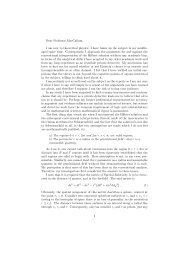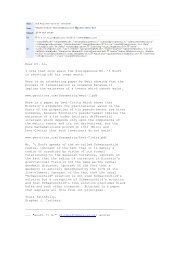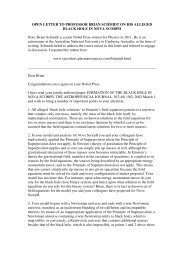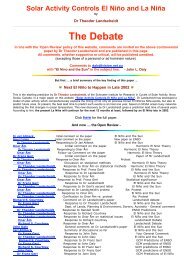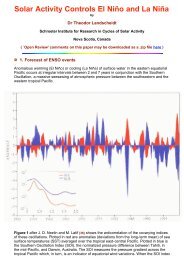THEODOR LANDSCHEIDT - The Golden Section - PlasmaResources
THEODOR LANDSCHEIDT - The Golden Section - PlasmaResources
THEODOR LANDSCHEIDT - The Golden Section - PlasmaResources
You also want an ePaper? Increase the reach of your titles
YUMPU automatically turns print PDFs into web optimized ePapers that Google loves.
<strong>The</strong> analysis of varves, the annual deposition of graded layers in glacial lakes, provides data on past climates. Thin<br />
varves usually indicate cold years and thick varves warm years. Dewey (1964) made a thorough analysis of varves<br />
taken from Lake Saki in Russia and found a cycle of 17-18 years. His crest data conform with consecutive cycles<br />
formed by half big fingers (Landscheidt 1990b). Statistically, the results, which cover 12 centuries, are highly<br />
significant (P = 10" ).<br />
Interestingly, the epochs of big fingertips and of national uprisings and revolutions follow the same rhythm: c. 1815<br />
uprising against Napoleon 1848 democratic movements and revolts in France, Italy, and central Europe c. 1878<br />
successful insurrection of Balkan countries against Turkish domination 1917-1918 revolutions in Russia and Germany<br />
1956 Hungarian revolt against Soviet occupation<br />
1987-1989 liberation of peoples in central and eastern Europe from communism. <strong>The</strong> next period of this kind is<br />
expected about the year 2026.<br />
A host of solar and terrestrial cycles are connected with small fingers. For example, FIGURE 9 is a plot of the number<br />
of south polar faculae on the sun, 1906 to 1975 (solid line). <strong>The</strong>re is no coincident movement with the magnetic 22year<br />
sunspot cycle (dashed line), but a neat synchronism with starting phases of small fingers (arrowheads) that<br />
coincide with ex-trema in the data of faculae, with one exception.<br />
A phase reversal—an irregular maximum instead of the regular minimum — occurs when the starting phase of a big<br />
finger in 1968 (flat triangle) collides with the initial phase of a small finger. <strong>The</strong> new rhythm continues until the next<br />
starting phase of a big finger intervenes. This general feature suggests the possibility to predict those phase jumps in<br />
time series that we often observe. This feature is found in terrestrial cycles, also.<br />
Figure 10 presents the U.S. building cycle, 1952 to 1987, as a plot of 9-year smoothed growth rates. Starting phases<br />
of small fingers (short arrows) and tips of small fingers (triangles) ran parallel with maxima in building activity until<br />
1968, the initial phase of a big finger (long arrow).<br />
After the disturbance by the big finger, the pattern changed completely: the starting phases indicated minima and the<br />
fingertips maxima. As expected, the next minimum phase began in 1990. <strong>The</strong> coming maximum phase should<br />
materialize in 1994. Different time series show different individual traits, but the fundamental pattern is always the<br />
same.<br />
FIGURE 11 is a plot of Standard & Poor's 500 index, 1963 to 1988, to which I added some markers (Landscheidt<br />
1989b). After the starting phase of a big finger (long arrow) in 1968, all deep bottoms in stock prices-1970, 1974,<br />
and 1982-coincided with starting phases of small fingers (fat arrows).<br />
This is why I had predicted for years that the next worldwide deep bottom in stock prices would occur in 1990. <strong>The</strong><br />
fat arrow outside the graph on the far right points to the pending event. In 19891 wrote: "Because of the imminent...<br />
event, the epoch of which is 1990.3, a bottom may be expected such as occurred in 1970, 1974, and 1982. But this<br />
will also be the start of a new rally" (Landscheidt 1989b). Both of these came about —the international bottom in<br />
stock prices and the ensuing rally with new record highs.



